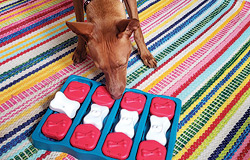When veterinarians and other pet care experts talk about "environmental enrichment," they're often referring to improving a cat's environment. However, all companion and captive animals can benefit from environmental enrichment. Today we will talk specifically about ways to enhance your dog's quality of life.
What Is Environmental Enrichment?
Environmental enrichment for pets, also called behavioral enrichment, means enhancing an animal's surroundings and lifestyle so that he is presented with novelty in his environment, opportunities to learn, and encouragement to engage in instinctive, species-specific behaviors.
Environmental enrichment is used to address many behavioral disorders in dogs, including rowdiness, cognitive dysfunction syndrome, storm and noise phobias, separation anxiety, obsessive-compulsive behaviors, and behaviors resulting from boredom and/or frustration.
In addition to treating behavioral disorders, environmental enrichment should be viewed as an essential part of providing an excellent quality of life for all pets, and especially handicapped animals and pets that don't leave home much, due to its proven positive effect on the health and well-being of animal companions. Here are the major components of canine environmental enrichment:
 Toys Toys
When you offer a new toy to your dog, you've probably noticed that while she's very excited by it initially, she loses interest within a day or so (or within hours or even minutes, depending on the dog and the toy). That's because dogs habituate to toys, meaning they get used to them. The new toy quickly becomes just another inanimate object in your dog's environment.
You can work around the problem by rotating your pet's toys. Provide your dog with a supply of different types of toys in varying shapes, sizes, textures, colors and even scents. A general guideline is to offer 2-3 toys per day. At the end of the day remove them (put them out of sight) and reintroduce them about every 5 days so they remain "new" to your dog.
Interactive toys like tug toys are always a good idea, because dogs love to play games with their humans!
Exercise
Dogs need daily exercise to be optimally healthy and emotionally balanced, and this goes double for young pets and high-energy breeds. It's important to understand that your dog — no matter how small—can't get adequate exercise running around your home or backyard by himself. Even if your yard is as large as an acre, they still need structured aerobic exercise.
In a perfect world, every dog would have opportunities to do some high-intensity endurance running on a regular basis to release endocannabinoids, which are the "happy hormones" responsible for the "runner's high" in both humans and canines. Once or twice a week can do wonders for those dogs and humans who able to participate in this activity.
Most dogs don't engage in intense exercise with their owners for a variety of reasons, but your dog really does need your help to get the most out of exercise and playtime. There are lots of activities you can enjoy with your pet, no matter your own level of physical fitness or limitations.
―Take a walk or hike with your dog
― Play a game of tug-of-war
― Roller blade or jog with your dog
― Take your dog for a swim and play fetch in the water
― Take a bike ride alongside your dog using a special dog bike leash
― Play hide-and-seek with treats or your dog's favorite toys
― Use a ball launcher to extend the distance your dog runs to retrieve and return the ball
Walking Your Dog a different way
Another way to enhance your dog's experience of her environment is to take her on a variety of different types of walks.
There are short purposeful walks in which your pet will only be outside long enough to relieve herself.
There are mentally stimulating walks during which your dog is given time to stop, sniff, investigate, mark a spot, and discover the great outdoors with her nose and other senses. Most leashed dogs don't get to spend much time sniffing and investigating. Allowing your pet time to explore canine-style is good for him mentally. Dogs gather knowledge about the world through their noses.
There are training walks that can expand your dog's skills and confidence. You can use them to improve his leash manners, teach basic or advanced obedience commands, or for ongoing socialization opportunities.
You might also want to consider power walks to improve your dog's fitness level (and yours!).
Social Enrichment
If your canine companion does well at the dog park, visits there can provide opportunities for dog-to-dog interaction, exercise, and vigorous play.
If you have friends with dogs, arrange play dates. These can be excellent low-pressure social situations for dogs that need to hone their interaction skills without being overwhelmed by too many dogs, or an overly dominant dog.
Involve your dog in agility, obedience, nose work, tracking, flyball, canine freestyle or another dog-centered event.
Additional Enrichment Strategies
Provide your dog with visual enrichment by giving her a view outside through a window (unless she's reactive to external stimuli).
Provide auditory enrichment by leaving a television or radio on, playing music or outdoor sounds, and offering your dog toys that make noise.
Provide tactile enrichment by petting, massaging, and brushing your dog. Make sure to follow her cues for what type of touch she does and doesn't like.
Appeal to your dog's olfactory senses by placing her toys in the clothes hamper so they pick up the scent of her humans. Use essential oils that are safe for dogs. Hide treats around the house or in cardboard boxes.
Puzzle and treat release toys can help focus the attention of high-energy dogs and keep dogs with storm phobia or separation anxiety occupied before and during anticipated stressful events. Lick mats and food-release "brain game" toys never get old, once your pup catches on.
|